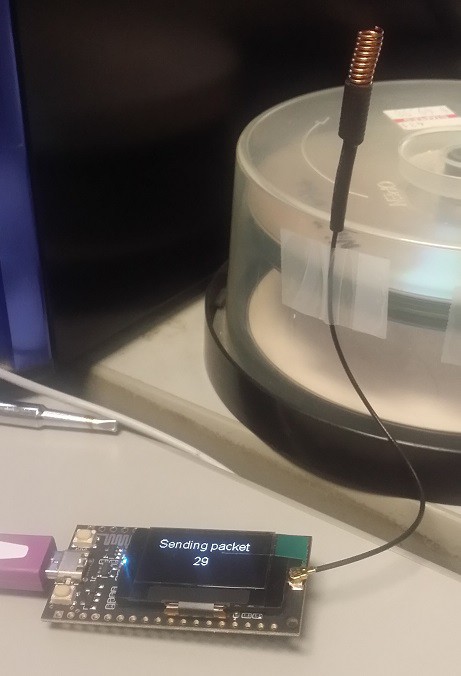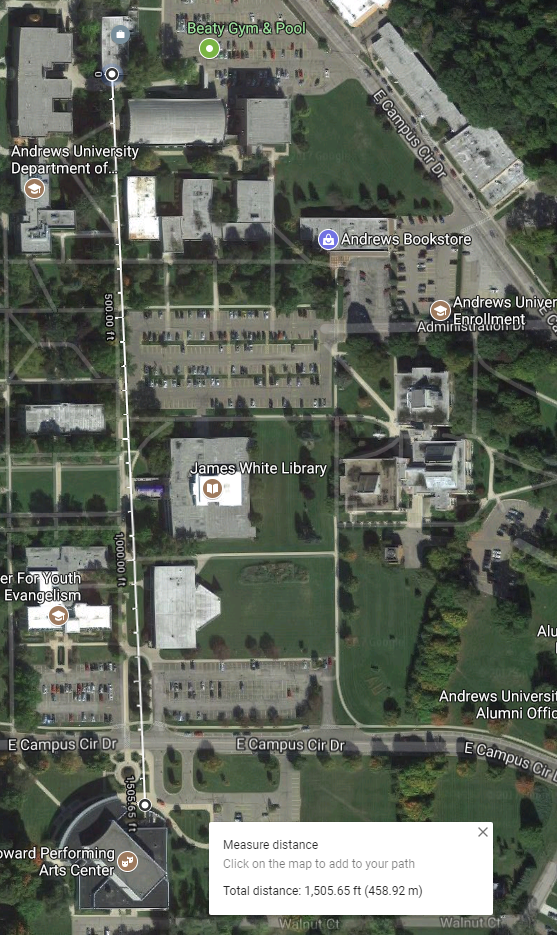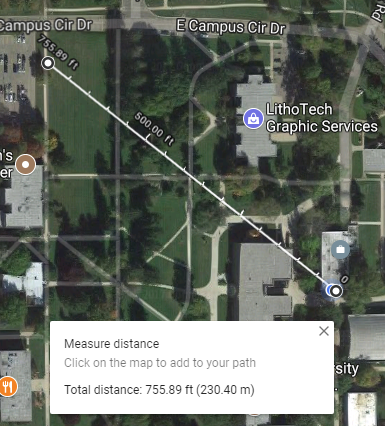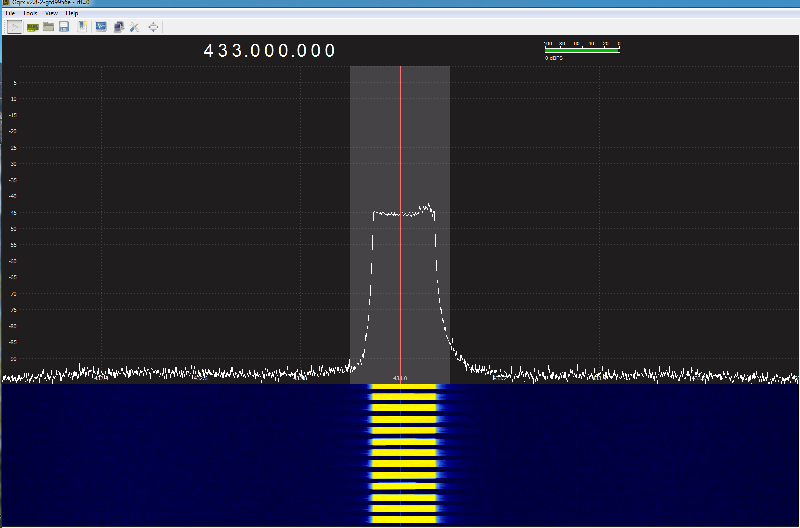Range Testing

Testing the TTGO Modules
I spent a couple of hours this morning gathering some data from my two TTGO ESP32-LoRa radios to try to determine the best settings to use to get reliable communications in weak signal conditions. For the purposes of these tests I needed a relatively poor signal path so I wouldn't have to walk too far to run out of signal. To this end I placed the module programmed as the transmitter on my desk right next to my computer. My desk is located in a cubicle on the second floor of a brick building so it is surrounded on 3 sides by the (mostly) steel cubicle walls in addition to the usual clutter of steel and brick. The remaining side (south facing) is next to a window that looks down the longest sidewalk on campus.


Signal Paths
I chose two signal paths for evaluation. The first is straight down the sidewalk outside my window 1500ft (457m) to the entrance of the performing arts center. Along this path there are no buildings that stand directly in the way however there are quite a few trees. The path has buildings on either side that are likely to provide for some multipath reflections. The second signal path is a more difficult one in terms of RF penetration. The far point of that path is about 750ft (228m) to the northwest of my office. Signals traversing this path must pass through the wall of my cubicle as well as that of two adjacent cubicles. In addition the signal travels through the brick wall of my building and passes through the corner of a nearby building on the way. This path has less multipath opportunities but greater signal attenuation than the first path. To make the observations I walked both paths while watching the received packets on the OLED screen of my second TTGO module.
Test Settings
For all of the tests the transmitter was set to a center frequency of 433.000mHz with the transmitter power level of 20dBm. Neither figure was verified as I don't have the test gear to do so. The bandwidth setting of the LoRa modulator was set to 125kHz and forward error correction was set at 8/4 for all tests. The antennas used were the 'coil spring' antennas supplied with the modules. Packets consisted of my Amateur Radio callsign followed by a space, a # character, and a sequential number. They varied in length from 8 to 11 characters. I varied the LoRa spreading factor from 7 to 11 and took readings of RSSI and reported SNR from the receiver at the far end of each path. The receive antenna was held at about 1 meter off the ground and oriented vertically to match the transmitter antenna. The data are shown below:
| Spreading factor | RSSI (path 1) | SNR (path 1) | RSSI (path 2) | SNR (Path 2) |
| 7 (128 chips/bit) | -114 dBm | 13.25 dB | -111 dBm | 14.5 dB |
| 8 (256 chips/bit) | -109 dBm | 14.0 dB | -113 dBm | 14.25 dB |
| 9 (512 chips/bit) | -105 dBm | 15.5 dB | -107 dBm | 16.25 dB |
| 10 (1024 chips/bit) | -106 dBm | 16.5 dB | -105 dBm | 16.75 dB |
| 11 (2048 chips/bit) | -103 dBm | 17.75 dB | -102 dBm | 17.25 dB |

Observations
While the reported signal levels and SNR figures all appeared to improve as I increased the spreading factor, I didn't see the amount of improvement that I might have been led to expect from reading Semtech's marketing literature. I also noticed that contrary to what one might intuitively expect, as the spreading factor was increased the reliability of packet receipt while moving (walking) went down considerably. By the time I got to sf = 11 there were practically no packets being received while moving but reception would resume immediately when I stopped and held the receiver still. I believe that this may have been the result of multipath distortion since it affected path 1 more than path 2 and was worse adjacent to buildings beside the path. The most reliable packet reception while moving was at sf = 7. In fact this was the only setting that worked at all from inside my car while driving around the campus perimeter road. I credit the more robust throuhput in motion to the much shorter packet transmission time at sf = 7. I am somewhat skeptical of both the RSSI figures and the SNR figures reported by the units. The RSSI numbers are not too far from what outdoor propagation calculators suggest for typical path loss at 430 Mhz but the SNR numbers don't vary sensibly over the path and often jump between very low numbers like 5 or 6 dB and the numbers reported in the table with no obvious reason.
Some Possibly Useful Links
Finding details on how LoRa radio links work under the hood can be difficult. Here are a few links to some information on the inner workings of LoRa.
1. A discussion on using SDR radio to emulate LoRa modules
-- https://myriadrf.org/blog/lora-modem-limesdr/
2. A very detailed slide set from a talk on LoRa
-- http://www.jailbreaksecuritysummit.com/s/Reversing-Lora-Knight.pdf
3. A wiki with several further references on LoRa
-- https://revspace.nl/DecodingLora
4. Semtech LoRa calculator
-- http://www.semtech.com/apps/filedown/down.php?file=SX1272LoRaCalculatorSetup1%271.zip
5. Semtech application note AN1200.24 "Recommended Settings for LoRaWAN"
-- http://www.semtech.com/images/datasheet/an1200.24.pdf
6. Semtech data sheet for SX1276-9 series LoRa radio modules
-- http://www.semtech.com/images/datasheet/sx1276_77_78_79.pdf
These should keep even the most curious busy reading for a while. I'll add more as I find them.
Legal Considerations
In addition to information on the workings of LoRa modules, one question that often comes up is that of what is allowed in the way of radio transmission. In the USA there are several different sets of regulations that may apply to the use of LoRa modules like those built into the TTGO and HelTec boards. The first is Amateur Radio regulations. Both the 433 mHz and 915 mHz bands fall within the limits of Amateur Radio frequencies so if you are licensed as a US amateur operator then you can use the boards in these bands provided you do so in compliance with US FCC regulations covering amateur radio.
If you aren't an amateur radio operator the situation is considerably more bleak. You could qualify your devices under FCC Part 15 regulations (unlicensed operation) but the paperwork and expense required to qualify render this a non-starter unless you are developing a commercial product and expect to sell quite a few. That being said, the principle of quiet non-compliance may be your best option here. Remember, if it quacks like a duck,,, it will probably be mistaken for one. That is, if you make sure your project operates in a manner very similar to things that meet the legal standard and does not cause interference to others it will most probably go unnoticed. To this end the following document may be helpful
-- https://linxtechnologies.com/wp/wp-content/uploads/fcc_resource_document.pdf
So much for US based experimenters... Those located in the EU or in other regions would do well to pay similar attention to local customs whether operating legally or not.
Discussions
Become a Hackaday.io Member
Create an account to leave a comment. Already have an account? Log In.
Valuable Lora under the hood information are included in robyns document https://robyns.me/docs/robyns2018lora.pdf
Are you sure? yes | no